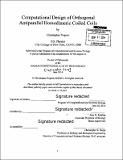Computational design of orthogonal antiparallel homodimeric coiled coils
Author(s)
Negron, Christopher
DownloadFull printable version (21.92Mb)
Other Contributors
Massachusetts Institute of Technology. Computational and Systems Biology Program.
Advisor
Amy E. Keating.
Terms of use
Metadata
Show full item recordAbstract
Living cells integrate a vast array of protein-protein interactions (PPIs) to govern cellular functions. For instance, PPIs are critical to biosynthesis, nanostructural assembly, and in processing environmental stimuli through cell-signaling pathways. As fields such as synthetic biology and protein engineering mature they seek to mimic and expand the functions found in living systems that integrate PPIs. A critical feature to many PPIs that are integrated together to perform a complex function is orthogonality, i.e. PPIs that do not cross interact with each other. The engineering of orthogonal PPIs is thus an alluring problem. Since it not only tests our understanding of molecular specificity by having to stabilize and destabilize interactions simultaneously. The results of the design process can also have interesting applications in synthetic biology or bionanotechnology. The coiled coil, a rope-like structure made of helices, is a PPI ubiquitously found in biological systems and is an attractive fold for engineering orthogonal PPIs. Though the coiled coil is well studied, destabilization of undesired interactions still remains challenging. In this thesis I will discuss strategies for obtaining orthogonal PPIs, and describe the current sequence-to-structure relationships known about coiled coils. I will then introduce the computational multistate design framework, CLASSY, and explain how I applied it to the computational design of six orthogonal antiparallel homodimeric coiled coils. Five of these designed sequences were experimentally tested, of which only three of the sequences adopted the target antiparallel homodimer topology. All three of these sequences, as well as a previously designed antiparallel homodimer, were tested for cross reactivity in a pairwise manner. None of these sequences appeared to cross react. The sequences that failed to adopt the antiparallel topology highlight the need for improving our computational design framework. In the final chapter I will discuss strategies to improve our models, and applications for orthogonal antiparallel coiled coils.
Description
Thesis: Ph. D., Massachusetts Institute of Technology, Computational and Systems Biology Program, 2014. Cataloged from PDF version of thesis. Includes bibliographical references.
Date issued
2014Department
Massachusetts Institute of Technology. Computational and Systems Biology ProgramPublisher
Massachusetts Institute of Technology
Keywords
Computational and Systems Biology Program.